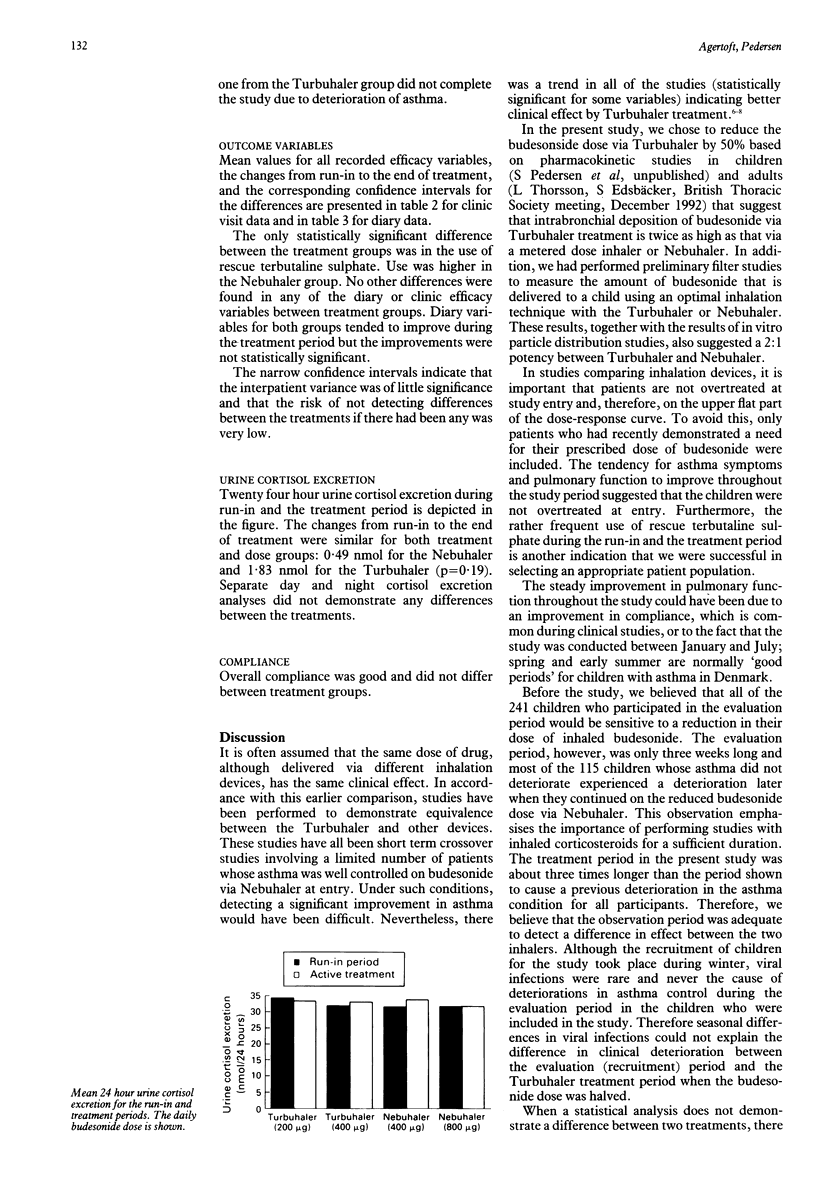Abstract
Two hundred and forty one children with chronic perennial asthma, who had been treated with budesonide via a metered dose inhaler with a spacer device (Nebuhaler), had their normal dose of budesonide reduced by 50% to determine if they had been overtreated. Within three weeks, asthma control deteriorated in 126 patients to such an extent that budesonide had to be increased to the normal dose. After stabilising their asthma, these children were enrolled in a randomised, double blind, double dummy, parallel study, performed to compare the effect of budesonide via Nebuhaler with that of half the dose of budesonide via Turbuhaler. The study started with a two week run-in during which patients were treated with their normal dose of budesonide via Nebuhaler. After run-in, 64 children were randomised to treatment with their normal budesonide treatment and the remaining 62 children to treatment with half their normal dose via Turbuhaler for nine weeks. Throughout the study, patients recorded asthma symptoms, peak flow measurements, and beta 2 agonist use in a diary. Pulmonary function tests, exercise tests, and 24 hour urine sample collections were performed at hospital visits during run-in and the study period. Apart from beta 2 agonist use, which was significantly lower for patients on Turbuhaler treatment than on Nebuhaler treatment, there were no differences between the groups in any of the parameters studied during run-in or during the study period. Furthermore, there was no trend of deterioration in asthma control when the dose of budesonide was reduced by 50% when Turbuhaler was the inhalation device. It is concluded that budesonide via Turbuhaler is more effective than via Nebuhaler in the treatment of asthma. Based on this finding, attempts should be made to reduce the dose of budesonide when patients are switched from Nebuhaler to Turbuhaler treatment.
Full text
PDF



Selected References
These references are in PubMed. This may not be the complete list of references from this article.
- Bisgaard H., Pedersen S., Damkjaer Nielsen M., Osterballe O. Adrenal function in asthmatic children treated with inhaled budesonide. Acta Paediatr Scand. 1991 Feb;80(2):213–217. doi: 10.1111/j.1651-2227.1991.tb11836.x. [DOI] [PubMed] [Google Scholar]
- Brown P. H., Blundell G., Greening A. P., Crompton G. K. Do large volume spacer devices reduce the systemic effects of high dose inhaled corticosteroids? Thorax. 1990 Oct;45(10):736–739. doi: 10.1136/thx.45.10.736. [DOI] [PMC free article] [PubMed] [Google Scholar]
- Engel T., Heinig J. H., Malling H. J., Scharling B., Nikander K., Madsen F. Clinical comparison of inhaled budesonide delivered either via pressurized metered dose inhaler or Turbuhaler. Allergy. 1989 Apr;44(3):220–225. doi: 10.1111/j.1398-9995.1989.tb02266.x. [DOI] [PubMed] [Google Scholar]
- Farrer M., Francis A. J., Pearce S. J. Morning serum cortisol concentrations after 2 mg inhaled beclomethasone dipropionate in normal subjects: effect of a 750 ml spacing device. Thorax. 1990 Oct;45(10):740–742. doi: 10.1136/thx.45.10.740. [DOI] [PMC free article] [PubMed] [Google Scholar]
- Fuglsang G., Pedersen S. Comparison of a new multidose powder inhaler with a pressurized aerosol in children with asthma. Pediatr Pulmonol. 1989;7(2):112–115. doi: 10.1002/ppul.1950070211. [DOI] [PubMed] [Google Scholar]
- Hultquist C., Ahlström H., Kjellman N. I., Malmqvist L. A., Svenonius E., Melin S. A double-blind comparison between a new multidose powder inhaler (Turbuhaler) and metered dose inhaler in children with asthma. Allergy. 1989 Sep;44(7):467–470. doi: 10.1111/j.1398-9995.1989.tb04184.x. [DOI] [PubMed] [Google Scholar]
- Johnsen C. R., Weeke E. R. Turbuhaler: a new device for dry powder terbutaline inhalation. Allergy. 1988 Jul;43(5):392–395. doi: 10.1111/j.1398-9995.1988.tb00434.x. [DOI] [PubMed] [Google Scholar]
- Persson G., Gruvstad E., Ståhl E. A new multiple dose powder inhaler, (Turbuhaler), compared with a pressurized inhaler in a study of terbutaline in asthmatics. Eur Respir J. 1988 Aug;1(8):681–684. [PubMed] [Google Scholar]
- Prahl P., Jensen T. Decreased adreno-cortical suppression utilizing the Nebuhaler for inhalation of steroid aerosols. Clin Allergy. 1987 Sep;17(5):393–398. doi: 10.1111/j.1365-2222.1987.tb02031.x. [DOI] [PubMed] [Google Scholar]
- Ryrfeldt A., Andersson P., Edsbäcker S., Tönnesson M., Davies D., Pauwels R. Pharmacokinetics and metabolism of budesonide, a selective glucocorticoid. Eur J Respir Dis Suppl. 1982;122:86–95. [PubMed] [Google Scholar]
- Selroos O., Halme M. Effect of a volumatic spacer and mouth rinsing on systemic absorption of inhaled corticosteroids from a metered dose inhaler and dry powder inhaler. Thorax. 1991 Dec;46(12):891–894. doi: 10.1136/thx.46.12.891. [DOI] [PMC free article] [PubMed] [Google Scholar]


